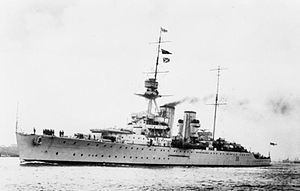Name HMS Frobisher Laid down 2 August 1916 Launched 20 March 1920 Builder HMNB Devonport | Commissioned 20 September 1924 Construction started 2 August 1916 Length 184 m | |
 | ||
Fate Sold for scrap 26 March 1949 | ||
HMS Frobisher was a Hawkins-class heavy cruiser of the Royal Navy. She was built at Devonport Dockyard and launched on 20 March 1920. She spent the majority of her career as a cadet training ship. She saw brief service during the Second World War being used for naval gunfire support. Following the war, the vessel was scrapped in 1949.
Contents
Interwar career
Frobisher was commissioned on 20 September 1924, and entered service with the Mediterranean Fleet as flagship of the 1st Cruiser Squadron. She was temporarily detached to serve on the China Station in 1926. In 1927 Frobisher underwent a refit that replaced one 4-inch (102 mm) gun, which was re-sited between the funnels with a fourth gun, with a catapult and a crane. In 1929 another refit gave Frobisher oil-fired boilers, and she then joined the Atlantic Fleet. In November 1930 Frobisher was reduced to reserve before being converted to a cadet's Training Ship, in which role she served from 1932 until 1939. She was laid up in early 1939, until the outbreak of the Second World War. In January 1940 Frobisher started an extensive refit, that rearmed her with five 7.5-inch, and five 4-inch (102 mm) guns, and quadruple 2 pounder pom-pom and 19 20 mm Oerlikons.
Wartime service
Frobisher joined the 4th Cruiser Squadron of the Eastern Fleet in March 1942 and commenced operations in the Indian Ocean, escorting convoys around the African coast, spending brief periods in the Selborne dry dock at Simonstown, South Africa. Frobisher returned to the UK in March 1944. She was involved in Operation Neptune on 6 June as a member of Gunfire Bombardment Support Force D allocated to Sword Beach in the D-Day landings. In the course of that operation, she fired five rounds per minute with her hand-loaded 7.5-inch guns, and scored a direct hit on the Grand Bunker at Ouistreham. Later that month she was deployed as a depot ship for the motor torpedo boats covering the naval forces. In August, she and the repair ship Albatross were damaged by long range German torpedoes fired from E-boats in Seine Bay. Frobisher was subsequently partly disarmed and reconverted into a Cadet Training Ship. She was sold to John Cashmore Ltd for scrap on 26 March 1949 and arrived at their yard at Newport to be broken up on 11 May of that year.
